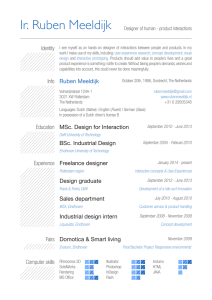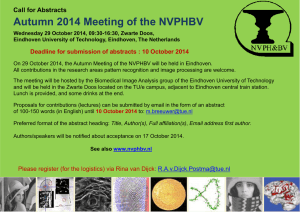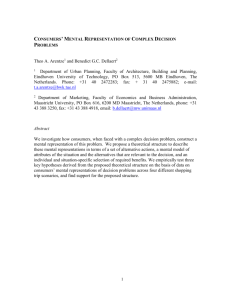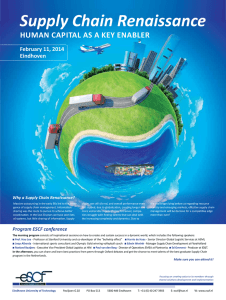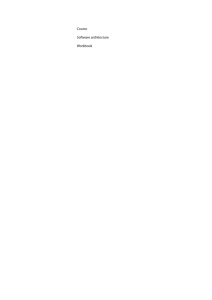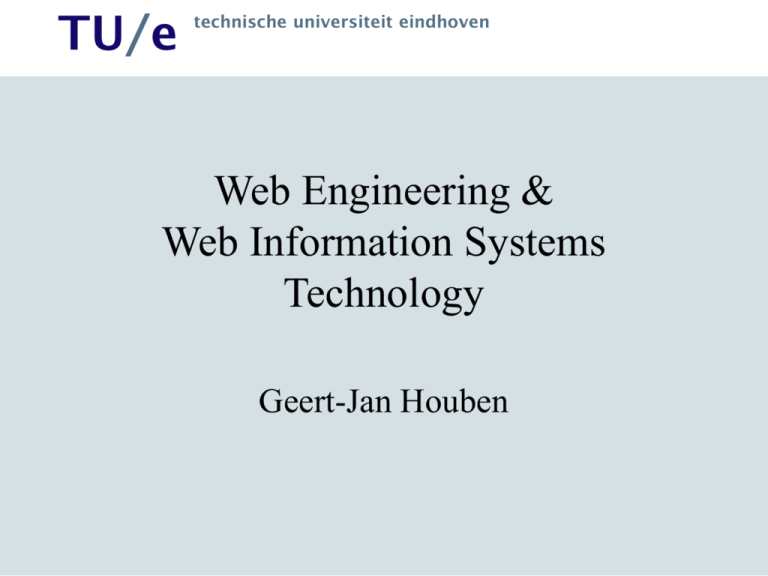
TU/e
technische universiteit eindhoven
Web Engineering &
Web Information Systems
Technology
Geert-Jan Houben
TU/e
technische universiteit eindhoven
Content
• Web information systems
• evolution
• WIS engineering
• XML & XQuery
• RDF & OWL
• Web services
• WS protocols
TU/e
technische universiteit eindhoven
Web Information Systems
TU/e
Web Information System
technische universiteit eindhoven
• Information System based on Web technology
(Web-based, Web-aware, Web-enabled etc.)
• Information system
– Exchanges information with Object System (= business
process)
– Stores and manages information: data-intensive
– Requires careful engineering of information exchange
TU/e
Web Information System
technische universiteit eindhoven
• Web technology can be used as front-end, e.g.
application is available on the Web (or Intranet)
via a browser
– Enables easy use and maintenance of (personalized)
end-user access
– Web metaphor is appealing for end-users
– Requires different techniques for engineering the
system’s interfaces
TU/e
Web Information System
technische universiteit eindhoven
• Web technology can also be used in back-end of
information system
– Organize (connect) the data inside the system using
Web technology
– Use World Wide Web as provider of data (or Intranet)
– Typically highly volatile information (distributed and
heterogeneous)
– Requires different techniques for engineering the
implementation
TU/e
technische universiteit eindhoven
Examples
•
•
•
•
•
•
•
•
Real-estate sales
Employee databases
Museum databases
Digital libraries
Mail order catalogs
Reservation systems
Auctions, virtual marketplaces
EPG (Electronic TV Program Guide)
Ref: Special section on Web Information Systems in Communications of the ACM, July 1998, Vol. 41,
No. 7
TU/e
technische universiteit eindhoven
Evolution in WIS Technology
TU/e
Evolution in hypermedia
technische universiteit eindhoven
• First: standalone special-purpose systems
• Now: Web-based
– From authoring to designing to generating
– From static to dynamic (generated from database query
result)
– From single site to portals (integrated access service)
– From read-only to interactive and often collaborative
(read-write)
TU/e
Evolution in Web Languages
technische universiteit eindhoven
1. HTML written by author
–
–
–
Easy, uniform interface
Large effort for maintenance
Not suited for changing information
2. Automatically generating information
–
–
First, using templates (and databases)
Later, using XML and XSLT transformations
3. Automatic processing of information
–
–
–
Explicit metadata (RDF)
Agreement on meaning (ontologies)
Semantic Web: from human-readable via machine-readable to
machine-processable
TU/e
SemWeb “Layer Cake”
technische universiteit eindhoven
TU/e
technische universiteit eindhoven
Other Views
• WebML: “A Web-enabled software system whose main purpose is to publish
and maintain large amounts of data”
– exploratory, browsing-oriented, personalized interfaces
– (highly volatile) data stored by means of DBMS technology
• OOHDM: “WWW brought new generation of IS”
– hypermedia navigation through heterogeneous information space
– operations querying or affecting that information
– constant change, new navigation and services
“Web-based applications, first good hypermedia applications”
• RMM: “History of graphics designers + programmers”
• Nielsen: “On the Web, the only constant is change. A site that works perfectly
as long as its stays the same will quickly die.”
“Healthy navigation structure key to success”
TU/e
technische universiteit eindhoven
WIS Engineering
TU/e
technische universiteit eindhoven
Device Dependency
HTML
SMIL
WML
TU/e
WIS Engineering Methodology
technische universiteit eindhoven
• Design of WIS requires careful engineering of
information exchange between IS and OS
• Implies engineering of front-end (interface) and
back-end (storage & retrieval)
• Professional applications: “from art to engineering”
– well-founded (software) engineering methodologies
– model-driven
TU/e
technische universiteit eindhoven
Hera: motivation
• Methodologies exist for manual hypermedia
presentation design, Hera targets automated
presentation
• Automated presentation is important for
databased content (the ‘deep web’) as opposed to
manually crafted content (the ‘surface web’):
most WIS are data driven
Ref: wwwis.win.tue.nl/~hera
TU/e
technische universiteit eindhoven
Hera Methodology
• Model-driven methodology, defines design phases:
– Conceptual Design that results in Conceptual Model
(CM, describes data content used for generation of
hypermedia presentations) construction
– Application Design that results in Application Model
(AM, describes the navigation structure and
functionality) construction
– Presentation Design that results in Presentation Model
(PM, describes spatial layout and rendering of
hypermedia presentations) construction
TU/e
technische universiteit eindhoven
Hera Models
• Models fully specify application; hence, there is no
need of additional programming
• Models are used by a generic Hera engine for
generation of WIS application pages (by on-demand
instantiations of model subsets)
TU/e
technische universiteit eindhoven
Hera Architecture
• Defines how the models are used for automatic
generation of hypermedia presentation
CM
Vocabulary
(RDFS)
AM
Vocabulary
PM
Vocabulary
CM
AM
PM
CM I
Content
AM I
Pres.
Browser
App. Context
Data
Semantic
Layer
Application
Layer
Presentation
Layer
Query/Context
M anager,
Form Processor
User
TU/e
technische universiteit eindhoven
Conceptual Model
• Provides a uniform semantic view over different
data sources that are integrated within a given
Web application.
• Consists of hierarchies of concepts relevant
within the given domain, their properties, and
relations.
TU/e
technische universiteit eindhoven
Conceptual Model
• Defines the data content in terms of RDFS
(concepts, attributes, properties)
String
tname
String
Integer
aname
year
exemplifies *
Technique
Artifact
examplified_by
String
cname
creates *
Creator
created_by
biography
description
String
Image
picture
Painting
paints *
painted_by
Painter
String
TU/e
technische universiteit eindhoven
Application Model
• Navigation structure of a hypermedia
application on top of CM
• Hypermedia dynamics (navigation structure
updates and application functionality) of a
hypermedia application
TU/e
technische universiteit eindhoven
Slices
Reference (link)
Slice
Technique
Painting
tname
picture
description
year
Owner concept
Attributes
exemplified_by
Set
painted_by
Painting
Painter
aname
Info
Sub-slices
Main
Main
TU/e
technische universiteit eindhoven
AM Example
initialize
Technique
SelectedPainting
Q1
tname
picture
description
aname
exemplified_by
Set
Set
year
painted_by
Painting
Basket
PaintingsForm
SelectedPainting
Main
Order
Main
Basket
quantity
includes
contains
Set
Order
SelectedPainting
aname
Main
Main
Main
quantity
quantity
aname
Q2
Painters
Main
i
cname
aname
bname
BuyForm
Painter
sN bname
TU/e
technische universiteit eindhoven
Data Manipulations
• Defined as SeRQL queries
• Used for processing forms (handle user input)
• Q1 creates instances of SelectedPainting according to the
SelectForm form content
CONSTRUCT
{P}<rdf:type>{acm:SelectedPainting>}
FROM
{P}<rdf:type>{cm:Painting};
<cm:aname>{Paname}
WHERE
Paname IN SELECT Faname
FROM {SF}<form:aname>{Faname},
{SF}<rdf:ID>{FormName}
WHERE FormName = “SelectForm”
SelectedPainting
type
type
Painting1
creates
...
PaintingN
TU/e
technische universiteit eindhoven
Hera Implementation
• HPG 2.0 (Hera Presentation Generator, dynamic
version) implemented in Java as a servlet
• Uses RDF API HP Jena for RDF data
transformations based on RDFS models (CM,
AM)
• Can use XForms processor
• Uses Sesame as main content repository and
application context repository; uses SeRQL/RQL
as query languages
• Set of graphical tools for designers for CM and
AM based on Visio
TU/e
technische universiteit eindhoven
XML & XQuery
TU/e
HTML = Hypertext Language
technische universiteit eindhoven
The <b> X23 </b> new camera
Ref
Name Price
replaces the <b> X22 </b>. It
X23 Camera 359.99
comes equipped with a flash
R2D2 Robot 19350.00
(worth by itself <i>53.99 $</i>)
Z25
PC
1299.99 hard and provides great quality for
only <i>359.99 $</i>.
Information System
Text + presentation
Where is the data ?
HTML
TU/e
XML for Semistructured Data
technische universiteit eindhoven
<product-table>
Ref
Name Price
< product reference=”X23">
X23 Camera 359.99
<designation> camera </designation>
R2D2 Robot 19350.00
<price unit=Dollars> 359.99 </price>
Z25
PC
1299.99
<description> … </description>
...
Information System easy </product>
< product reference=”R2D2">
<designation> Robot </designation>
Data + Structure:
<price unit=Dollars> 19350 </price>
<description> … </description>
more flexible
...
</product-table>
XML
TU/e
technische universiteit eindhoven
Complex data
• Structure is irregular (missing/extra data)
• Schema does not exist or is unknown
• Schema is rapidly evolving
• Relational and ODB models are too rigid
• Standard is a document/hypertext language HTML
• Solution: semistructured data model XML
– data model consists of a type definition language, a
query/update language and more
TU/e
technische universiteit eindhoven
XML
• XML: eXtensible Mark-up Language
– W3C and most industrial companies [B2B]
– Main idea: separate content and presentation
– Use tags to represent structure and semantics
• HTML: a fixed set of tags complicates the identification of
information elements
• XML allows to define data structures:
– Tags with freely chosen names
» No predefined tags enables definition, transmission, validation and
interpretation of data between applications (and organizations)
– Freely chosen attributes
Ref: w3c.org
TU/e
technische universiteit eindhoven
<purchaseOrder orderDate="1999-10-20">
<shipTo country="US">
<name>Alice Smith</name>
<street>123 Maple Street</street>
<city>Mill Valley</city>
<state>CA</state>
<zip>90952</zip>
</shipTo>
<billTo country="US">
<name>Robert Smith</name>
<street>8 Oak Avenue</street>
<city>Old Town</city>
<state>PA</state>
<zip>95819</zip>
</billTo>
<items>
<item partNum="872-AA">
<productName>Lawnmower</productName>
<quantity>1</quantity>
<USPrice>148.95</USPrice>
</item>
<item partNum="926-AA">
<productName>Baby Monitor</productName>
<quantity>1</quantity>
<USPrice>39.98</USPrice>
<shipDate>1999-05-21</shipDate>
</item>
</items>
</purchaseOrder>
TU/e
technische universiteit eindhoven
XML Documents
•
•
•
•
•
•
elements and attributes
elements are ordered
attribute values are strings
well-formed documents (e.g. proper nesting)
namespaces: vocabularies for tags
valid documents: DTD, Schema
TU/e
technische universiteit eindhoven
DTD: a grammar
Product*
Name Price? Cat
(Part Quantity)*
Part
BasicPart + ComposedPart
BasicPart
Name
ComposedPart Name (Part Quantity)*
Catalog
Product
TU/e
technische universiteit eindhoven
<xsd:schema xmlns:xsd="http://www.w3.org/2001/XMLSchema">
<xsd:annotation>
<xsd:documentation xml:lang="en">
Purchase order schema for Example.com.
Copyright 2000 Example.com. All rights reserved.
</xsd:documentation>
</xsd:annotation>
<xsd:element name="purchaseOrder" type="PurchaseOrderType"/>
<xsd:element name="comment" type="xsd:string"/>
<xsd:complexType name="PurchaseOrderType">
<xsd:sequence>
<xsd:element name="shipTo" type="USAddress"/>
<xsd:element name="billTo" type="USAddress"/>
<xsd:element ref="comment" minOccurs="0"/>
<xsd:element name="items" type="Items"/>
</xsd:sequence>
<xsd:attribute name="orderDate" type="xsd:date"/>
</xsd:complexType>
<xsd:complexType name="USAddress">
<xsd:sequence>
<xsd:element name="name" type="xsd:string"/>
<xsd:element name="street" type="xsd:string"/>
<xsd:element name="city" type="xsd:string"/>
<xsd:element name="state" type="xsd:string"/>
<xsd:element name="zip" type="xsd:decimal"/>
</xsd:sequence>
<xsd:attribute name="country" type="xsd:NMTOKEN" fixed="US"/>
</xsd:complexType>
...
</xsd:schema>
TU/e
technische universiteit eindhoven
...
<xsd:complexType name="Items">
<xsd:sequence>
<xsd:element name="item" minOccurs="0" maxOccurs="unbounded">
<xsd:complexType>
<xsd:sequence>
<xsd:element name="productName" type="xsd:string"/>
<xsd:element name="quantity">
<xsd:simpleType>
<xsd:restriction base="xsd:positiveInteger">
<xsd:maxExclusive value="100"/>
</xsd:restriction>
</xsd:simpleType>
</xsd:element>
<xsd:element name="USPrice" type="xsd:decimal"/>
<xsd:element ref="comment" minOccurs="0"/>
<xsd:element name="shipDate" type="xsd:date" minOccurs="0"/>
</xsd:sequence>
<xsd:attribute name="partNum" type="SKU" use="required"/>
</xsd:complexType>
</xsd:element>
</xsd:sequence>
</xsd:complexType>
<!-- Stock Keeping Unit, a code for identifying products -->
<xsd:simpleType name="SKU">
<xsd:restriction base="xsd:string">
<xsd:pattern value="\d{3}-[A-Z]{2}"/>
</xsd:restriction>
</xsd:simpleType>
</xsd:schema>
TU/e
technische universiteit eindhoven
Typing XML
• Not really, the true spirit of the Web, but essential
for data management: query optimization, user
interfaces, applications
• Differences with standard database typing
– Collections are sequences instead of sets
– Types may be very large (e.g., from integration)
– Data is more irregular so types should be more
permissive
– New issues sometimes: you have the data, extract its
type: an approximate type
TU/e
technische universiteit eindhoven
<skills>
<people>
<person>
<name>Bob</name>
<know-how>XML</know-how>
</person>
<person>
<name>Peter</name>
<know-how>XML</know-how>
<know-how>RDF(S)</know-how>
</person>
</people>
<seminars>
<seminar>
<topic>XML</topic>
<participant>
<name>Karin</name>
<name>Alice</name>
</participant>
</seminar>
</seminars>
</skills>
TU/e
technische universiteit eindhoven
//person/name[../know-how=“XML"]
$union$
//seminar[topic=“XML"]/participant/name
TU/e
technische universiteit eindhoven
XPath
• Path expressions in OO databases
/Students/Student/Status
• Semistructured:
– missing parts
/Students//Status
– conditions
/Students/Student[Status=“U4”]
• Indexing, wildcards
• Selection, string manipulation, aggregation,
attribute existence, union
TU/e
technische universiteit eindhoven
XSLT
• XSL: XML Stylesheet Language
– (XSLT: XSL Transformations)
• declarative language for transforming XML
documents using an XSLT processor
TU/e
technische universiteit eindhoven
XQuery
• http://www.w3.org/XML/Query
• “the” standard for XML querying
• Goal: “data model for XML documents, a set of
query operators on that data model, and a query
language based on these query operators”
• General query language (next to XPath + XSLT)
• Based on XPath
TU/e
XQuery Path Expressions
technische universiteit eindhoven
In the second chapter of the document named “zoo.xml”, find the
figure(s) with caption “Tree Frogs”.
document(“zoo.xml”)/chapter[2]//
figure[caption=“Tree Frogs”]
Find captions of figures that are referenced by <figref> elements in the
chapter of “zoo.xml” with title “Frogs”.
document(“zoo.xml”)/chapter[title=“Frogs”]//
figref/@refid->fig/caption
TU/e
XQuery Element Constructor
technische universiteit eindhoven
Generate an <emp> element that has an “empid” attribute. The value of
the attribute and the content of the subelements are specified by
variables that are bound in other parts of the query.
<emp empid={$id}>
{$name}
{$job}
</emp>
TU/e
XQuery FLWR Expression
technische universiteit eindhoven
List each publisher and the average price of its books.
FOR $p IN distinct(document(“bib.xml”)//publisher)
LET $a := avg(document(“bib.xml”)/book[publisher=$p]/price)
RETURN
<publisher>
<name>{$p/text()}</name>
<avgprice>{$a}</avgprice>
</publisher>
TU/e
technische universiteit eindhoven
RDF & OWL
TU/e
technische universiteit eindhoven
Web Data Integration
• WIS repository (back-end) typically assembled
from different heterogeneous sources, e.g.
databases, files, WWW
• To manage (coordinate) data from different
sources, metadata helps to structure the data
TU/e
technische universiteit eindhoven
Metadata
•
•
•
•
Describing the data and its availability
Sometimes provided by sources
Needed by IS
Engineering metadata:
– Meaning
– Validity
– Quality
• Specifying “logistics” of data
TU/e
Resource Description Framework
technische universiteit eindhoven
• W3C standard for metadata description
• Describes the “meaning” of data like Web sites, parts
of HTML pages, etc.
• Makes data “machine - understandable” – allows
automated data processing
• Framework that allows you to make simple assertions
about anything: distributed and extensible (as is the
Web)
• “meaning” expressed via “subclass of”
Ref: www.w3.org/RDF, www.w3.org/TR/rdf-primer
TU/e
technische universiteit eindhoven
Basic RDF Model
• Recognizes 3 object types:
– Resources – always named by URI, e.g. web
site, part of web page, others
– Properties – an attribute of a Resource, its
characteristics
– Statements – Resource + Property + Property
Value
TU/e
Basic RDF Model Example
technische universiteit eindhoven
• RDF representation of the sentence:
“Ora Lassila is the creator of the resource
www.w3.org/Home/Lassila.”
Statement:
Subject (Resource)
www.w3.org/Home/Lassila
Predicate (Property)
Object (Literal)
Creator
“Ora Lassila”
TU/e
Basic RDF Model Example
technische universiteit eindhoven
• Diagram of the statement:
Creator
www.w3.org/Home/Lassila
Ora Lassila
TU/e
technische universiteit eindhoven
RDF and XML
•RDF can be implemented using XML
•The example of complete XML for the previous
example is:
<?xml version=“1.0”>
<rdf:RDF
xmlns:rdf=“http://www.w3.org/1999/02/22-rdf-syntax-ns#”
xmlns:s=http://description.org/schema/>
<rdf:Description about=www.w3.org/Home/Lassila>
<s:Creator>Ora Lassila</s:Creator>
</rdf:Description>
</rdf:RDF>
TU/e
Structured Value Example
technische universiteit eindhoven
• “The employee with ID 85740, Ora Lassila, with
Email lassila@w3.org, is the creator of the
resource www.w3.org/Home/Lassila”
In XML it is:
www.w3.org/Home/Lassila
<rdf:RDF>
<rdf:Description about=“www.w3.org/Home/Lassila”>
<s:Creator>
Creator
<rdf:Description about=“www.w3.org/staffid/85740”>
www.w3.org/staffid/85740
<v:Name>Ora Lassila</v:Name>
<v:Email>lassila@w3.org</v:Email>
Name
Email
</rdf:Description>
</s:Creator>
Ora Lassila
Lassila@w3.org
<rdf:Description>
</rdf:RDF>
TU/e
technische universiteit eindhoven
RDF - more
• It is possible to make statements about
statements
• It is possible to refer a collection of
resources (containers) of 3 types:
– Bag – a property has multiple values, order has no
significance
– Sequence – a property has multiple value, order is
significant
– Alternative – list of literals/resources representing
alternatives for single property
TU/e
RDF Query Language
technische universiteit eindhoven
• Querying RDF metadata
– SQL/XQL style approach, viewing RDF metadata as
relational or XML database [RDF Query Specification
(IBM)]
– viewing Web descriptions by RDF metadata as knowledge
base, applying knowledge representation and reasoning
techniques [W3C related]
• RQL, SeRQL (with Sesame)
TU/e
technische universiteit eindhoven
Meaning: Ontologies
•
•
•
Ontology = a vocabulary with associated
meaning (“shared understanding”)
Possibility to define synonyms,
specializations and other relationships
Use of same ontology = contract on meaning
of words (tags, attributes)
•
Often, industry or domain dependent
TU/e
technische universiteit eindhoven
OWL
• Web Ontology Language
• used to explicitly represent meaning of terms in
vocabularies and relationships between terms:
ontology
– ontology engineering
• beyond XML and RDF(S)
• revision of DAML+OIL
TU/e
technische universiteit eindhoven
Stack
• XML: surface syntax for structured documents (no
semantic constraints on meaning)
• XML Schema: restricting structure of XML documents
• RDF: datamodel for objects (resources) and relationships,
provides simple semantics for this datamodel
• RDF Schema: vocabulary for describing properties and
classes of RDF resources, with semantics for
generalization-hierarchies
• OWL: adds vocabulary for describing properties and
classes, e.g. relations between classes (disjoint),
cardinality (exactly one), equality, richer typing of
properties, characteristics of properties (symmetry),
enumerated classes
TU/e
technische universiteit eindhoven
OWL Sublanguages
• OWL Lite: classification hierarchy and simple
constraints
• OWL DL: maximum expressiveness while
retaining computational completeness and
decidability (description logics)
• OWL Full: maximum expressiveness and
syntactic freedom of RDF with no computational
guarantees
TU/e
technische universiteit eindhoven
Web Services
TU/e
technische universiteit eindhoven
Web Services
– Distributed computing model on asynchronous
messaging (XML)
• Support dynamic application integration over the
Web
• XML message for exchanging data and accessing
services
• On-the-fly software creation through the use of
loosely coupled, reusable software components
• Software can be delivered and paid per-use as
opposed to package products
TU/e
technische universiteit eindhoven
Principles
• XML Message Exchange
– Message Transport
• XML
• Namespaces (URI)
• HTTP
Application
Client
Web Service
<B>
XML
– Message Nature
• Request
• Result of a request
• Errors
Web Service
<C>
Web Service
<D>
TU/e
technische universiteit eindhoven
Application
Client
XML
• Design Principles
HTTP-SOAP
– Wrapping services (applications)
– Web-based protocols
Web Service
<D>
• Web-services based on HTTP
– Protocols can traverse firewalls, can work in a
heterogeneous environment
– Interoperability
• SOAP defines a common standard that allows different
systems to interoperate
– XML-based (XML Schema)
• Machine-readable documents
TU/e
technische universiteit eindhoven
Application
Client
Repository
XML
• Design Principles
HTTP-SOAP
– Modularity
• Service components are useful in themselves,
reusable, composable
Web Service
– Availability
Application
• Services are available to systems that wish to use them
• Services must be exposed outside of the particular system they
are available in (wrapping)
– Machine-readable description
• Used to identify the interface, the location and access
information
– Published
• Searchable service repositories of service descriptions
TU/e
technische universiteit eindhoven
Related Technologies
• Comparison with Data Wrapping
– Same idea (providing a transparent interface to legacy systems)
– Data (data models and query languages) vs. services (procedures,
functions)
• Comparison with other RPC
– Existing RPC (DCOM, RMI or CORBA)
• Same idea (interface, dynamic discovery, protocols)
• Interoperability problems
– DCOM: Microsoft
– RMI: Java
• Technical problems
– CORBA: very complex
TU/e
technische universiteit eindhoven
Main Components/Actors
Directory
Service
Description
Discovery
Service
Description
Client
Client
Application
Publication
Service
Provider
Interaction
Web
Service
TU/e
technische universiteit eindhoven
Publication and Discovery: UDDI
Service Description: WSDL
Messaging: SOAP
Transport: HTTP, SMTP, FTP
• Three Main Components/Protocols
– UDDI (Universal Data Description Interface)
• Directory for recording and searching the description of Web services
• Provides a mechanism for clients to find Web services
– WSDL (Web Services Description Language)
• XML description of a Web service
• Defines services as collections of network endpoint or ports
– A port is defined by associating a network address with a binding
(servers)
– A collection of ports defines a service
– SOAP (Simple Object Access Protocol)
• Is a message layout specification that defines a uniform ways of
passing XML-encoded data
• Based on HTTP
TU/e
technische universiteit eindhoven
Publication and Discovery: UDDI
Service Description: WSDL
Messaging: SOAP
Transport: HTTP, SMTP, FTP
Directory
UDDI
WSDL
Service
Description
Discovery
Client
Client
Application
SOAP
Publication
Service
Description
Service
Provider
Interaction
Web
Service
TU/e
technische universiteit eindhoven
Basic Usage Scenario
Client
(manual) Web
service lookup
Directory (UDDI)
2 http get
1 register
3 WSDL file
Write client
application
Run client
application
Publish Web
service
WSDL file
(manually)
4 SOAP request
Run Server
5 SOAP response
Web Service
Provider
TU/e
technische universiteit eindhoven
Web Service Implementation
Web Service Provider
Requestor
(SOAP client)
SOAP Message
(HTTP transport)
HTTP
Server
SOAP
Server
Application
Server
– Application server (Web service-enabled)
• Provides implementation of services and exposes it through WSDL/SOAP (Wrapping)
• Implementation in Java, as EJB, as .NET(C#), etc.
– SOAP server
• Implements the SOAP protocol
– HTTP server
• Standard Web server
– SOAP client
• Implements the SOAP protocol on the client site
TU/e
technische universiteit eindhoven
Web Service Classification
ebXML
– Communication and transport services
• W3C Recommendations
• SOAP, XML, Namespace
– Technical services
• W3C Recommendations
• Services for message
publication and exchange
• Examples: WSDL, UDDI
Enterprise
Web Service
Rosetta
Biztalk
Net
Business Service
SOAP
TCP-IP-HTTP
Technical Service
WSDL
UDDI
BPML
– Business services
• Specific for an activity area
• Defined and used by a group of companies working on the same activity area
• Examples: ebXML, RosettaNet, BizTalk
TU/e
technische universiteit eindhoven
Web Service Examples
– Google
• http://www.google.com/apis/
• Free but limited access
TU/e
technische universiteit eindhoven
Web Service Examples
– Amazon
• http://associates.amazon.com/exec/panama/associates/join/developer/resources.html
• Free but limited access
• Search and management
of Amazon products
– Access products
– Add products
– Customize presentations
TU/e
technische universiteit eindhoven
Web Service Examples
– SellerEngine (http://www.sellerengine.com/)
Uses Amazon Web Services
Brings Amazon data to a desktop in
real time (create new listings and
upload them to Amazon in seconds
using a easy to use interface)
TU/e
technische universiteit eindhoven
TU/e
technische universiteit eindhoven
WS Protocols
TU/e
technische universiteit eindhoven
Protocol: SOAP
• Simple Object Access Protocol
– Communication protocol via Internet between
applications: data exchange and data structures
– Format for sending messages
• Platform and language independent
• Based on XML
Directory
UDDI
– Messages with two types of elements
• Pre-defined tags
• Application-specific tags
WSDL
Service
Description
Publication
Discovery
Client
Client
Application
SOAP
Interaction
Service
Description
Service
Provider
Web
Service
TU/e
technische universiteit eindhoven
Protocol: SOAP
• SOAP: Communication and Transport Services
– SOAP document
–
–
–
–
Envelop: message type and destination
Data type: representation of data types
Conventions for the RPC and for the result or error sending
Rules for the SOAP transport on HTTP
Transport
SOAP
HTTP
TCP/IP
POST: …
Host: …
Content-type: …
Content-length: …
<Envelope>
<Body>
</Body>
</Envelope>
Message depends
on Web services
TU/e
technische universiteit eindhoven
Protocol: WSDL
• Web Services Description Language
– XML-based language for describing Web services and how to
access them
• Specification of the location
of the service
• Specification of the operations
(or methods) the service exposes
Directory
UDDI
WSDL
Service
Description
Publication
Discovery
Client
Client
Application
SOAP
Interaction
Service
Description
Service
Provider
Web
Service
TU/e
technische universiteit eindhoven
Protocol: WSDL
• Description of Web Services in XML format
– Abstract description of operations and their parameters
(messages)
– Concrete description
• Binding to a concrete network protocol (SOAP)
• Specification of endpoints for accessing the service
Abstract
Types: structure of messages
Messages: used by operations
Binding: concrete protocol
Concrete
Service: collection of related ports
Ports: Binding and a network address
TU/e
technische universiteit eindhoven
Protocol: UDDI
• Universal Description, Discovery and Integration
– Directory service where businesses can register and search for
Web services (described in WSDL)
– Communication via SOAP
Directory
UDDI
WSDL
Service
Description
Publication
Discovery
Client
Client
Application
SOAP
Interaction
Service
Description
Service
Provider
Web
Service
TU/e
technische universiteit eindhoven
Protocol: UDDI
• UDDI Support
– UDDI is a cross-industry effort driven by all major platform
and software providers like Dell, Fujitsu, HP, Hitachi, IBM,
Intel, Microsoft, Oracle, SAP, and Sun, as well as a large
community of marketplace operators, and e-business leaders
– Over 220 companies are members of the UDDI community
•
•
•
•
Microsoft (uddi.microsoft.com)
IBM (ibm.com/services/uddi)
HP (uddi.hp.com)
SAP (udditest.sap.com)
TU/e
technische universiteit eindhoven
Example: Flight Reservation
• If the industry published an UDDI standard for
flight rate checking and reservation, airlines could
register their services into an UDDI directory
• Travel agencies could then search the UDDI
directory to find the airline's reservation interface
• When the interface is found, the travel agency can
communicate with the service immediately because
it uses a well-defined reservation interface
TU/e
technische universiteit eindhoven
Microsoft’s UDDI
uddi.microsoft.com
Search of a
Web Service: Xmethods
Search Results
TU/e
technische universiteit eindhoven
Microsoft’s UDDI
Description of
the selected service
Returns book price from
Barnes and Noble
online store, given ISBN
TU/e
technische universiteit eindhoven
Microsoft’s UDDI
WSDL Description
of the Web service
TU/e
technische universiteit eindhoven
Service Development
Two main technologies
– Java (EJB server)
– .NET

